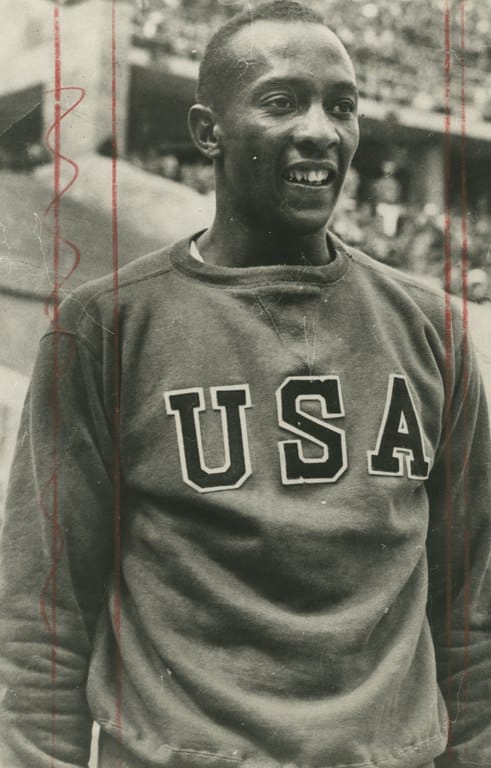
Photo by – Wikimedia
Top 10 Amazing Facts about Jesse Owens
James Cleveland “Jesse” Owens (September 12, 1913 – March 31, 1980) was an American track and field athlete who won four gold medals at the 1936 Olympic Games.
Owens specialized in the sprints and the long jump and was recognized in his lifetime as “perhaps the greatest and most famous athlete in track and field history”.
On the other side of the world in Germany members of “non-Aryan” (non-white and Jewish) races were perceived and portrayed as inferior and degenerate.
Nazi sports imagery served to promote the myth of Aryan racial superiority. So-called Aryan facial features blonde hair and blue eyes were accentuated in posters and journal illustrations.
From 1933 the Nazis’ sports office ordered all public athletic organizations to implement an “Aryans-only” policy.
The policy sparked global outrage: just two years earlier, the International Olympic Committee (IOC) had awarded the 1936 Summer Olympics to Berlin
Jesse Owens seized his moment at the Berlin Summer Olympics of 1936 where he won four gold medals and for many crushed Hitler’s theory of Aryan supremacy.
Here are 10 amazing facts about the life and achievements of one of the greatest track and field athletes nicknamed ‘Buckeye Bullet’.
1. Jesse Owen’s Mother Performed Surgery on him at Home to Save his Life

Image by Dominik Karch from Pixabay
Owens, the 10th and last child of a pair of poor sharecroppers, was a sickly child.
He regularly had thoracic infections such as chronic bronchial congestion and pneumonia.
But it was a lump on the frail 5-year-old’s chest that swelled over the course of several days that concerned his family the most especially when it began to painfully press against his lungs.
With no money to see a doctor, Owens’ mother, Emma eventually cut the lump off herself with a kitchen knife ss Owens bit down hard on a leather strap.
The golfball-sized incision spurted blood for days, but Owens survived.
2. Accidental Name Change
James Cleveland Owens(J.C.) was the youngest of ten children, three girls and seven boys, born to Henry Cleveland Owens and Mary Emma Fitzgerald in Oakville, Alabama.
The family moved to Cleveland, Ohio for better opportunities.
When his new teacher asked his name (to enter in her roll book), he said “J.C.”, but because of his strong Southern accent, she thought he said “Jesse”.
Owens was too shy to correct his new teacher in front of his new classmates
Hence he became Jesse Owens.
3. He was Nicknamed Buckeye Bullet for his Exploits in Ohio State

Photo by El Graffico – Wikimedia
Jesse Owens got the nickname Buckeye Bullet at Ohio State University because of the records he set.
After developing into a track and field star at a Cleveland high school, Owens enrolled at The Ohio State University.
While smashing records for the Ohio State Buckeyes track team, he became known as the “Buckeye Bullet.”
Owen is Ohio State varsity team’s first elected black captain.
However, the colour of his skin barred him from living in the on-campus dormitory.
4. Jesse Owens Set an Unequalled Greatest 45 Minutes in Sport

Photo by Le Miroir des sports – Wikimedia
He set three world records and tied another, all in less than an hour, at the 1935 Big Ten track meet in Ann Arbor, Michigan.
A feat that has never been equalled and has been called “The greatest 45 minutes ever in sport”
The sophomore speedster turned in a remarkable performance in spite of a severely injured tailbone.
Owens began the meet tying the world record in the 100-yard dash. Fifteen minutes later he smashed the world long jump record by nearly six inches.
Within the next half-hour, he also set world bests in the 220-yard dash and 220-yard low hurdles.
5. Jesse Owens Nearly Missed the 1936 Olympics USA Team Ticket

Photo courtesy of IOC, Switzerland – Wikimedia
Ohio State’s Owens burst into the national spotlight in May 1935 when he set three world records and tied another at the Big Ten Championships, but that summer he often found himself on the heels of Temple University’s Eulace Peacock.
Peacock bested Owens in the long jump and the 100 meters on July 4th, and at one point he beat Owens in five consecutive races.
Former Olympic gold medalist Charles Paddock noted that Peacock was the only clear-cut choice for an Olympic berth and Owens himself wondered how he could beat his new rival.
But Peacock suffered a pulled hamstring later that summer and tore the hamstring the following April and never got the chance to compete in the Olympics.
6. Jesse Owen Took Home 4 Gold Medals in One Olympiad
Although Adolf Hitler intended the 1936 Berlin Games to be a showcase for the Nazi ideology of Aryan racial supremacy it was a black man who left the biggest imprint on that year’s Games.
In one of the greatest performances in Olympic history, Owens captured gold in the 100 meters, long jump, 200 meters and 4×100 meter relay.
A street outside Berlin’s Olympic Stadium was christened Jesse-Owens-Allee in 1984.
The section of the Olympic Village in which the sprinter stayed during the 1936 Summer Olympics features displays about the American champion
7. Owens Participated in Stunt Races for Money Despite Olympic Glory

Photo Courtesy Germany Federal Archives – Wikimedia
In spite of his fame on his return from Berlin, Owens struggled for money and began to participate in stunt races against dogs, motorcycles and even horses during halftime of soccer matches and between doubleheaders of Negro League baseball games.
Owens would start 40 yards ahead of his equine competitors before sprinting for 100 yards, and he would often win by a nose.
The trick was to race a high-strung thoroughbred that would be frightened by the starter’s shotgun and give him a bad jump.
“People said it was degrading for an Olympic champion to run against a horse,” Owens said, “but what was I supposed to do? I had four gold medals, but you can’t eat four gold medals.”
8. The U.S President not Hitler Snubbed Jesse Owens
In the immediate aftermath of the Berlin Games, a myth arose that Hitler was enraged at the triumph of an African American.
It is alleged that he refused to congratulate Owens on his victories.
However, the press reported that the German leader gave the American sprinter a “friendly little Nazi salute,” and Owens said that the two exchanged congratulatory waves.
In fact, it was President Roosevelt who never invited Owens and the other 17 African American Olympians to the White House or acknowledged his triumphs.
The White House feted the other white athletes after the games.
The president didn’t even send me a telegram.” On the other hand, Hitler sent Owens a commemorative inscribed cabinet photograph of himself.
It wasn’t until 1955 when President Dwight D. Eisenhower honoured Owens by naming him an “Ambassador of Sports.”
In August 2009, the Daily Telegraph found a German sports reporter, Siegfried Mischner then aged 83, who claimed that Owens had shown him a photograph of Hitler shaking his hand after the 100 meters event, behind the stadium’s honour stand. There is no independent confirmation of this.
9. Jesse Owens was The First Sports Star to Endorse Adidas

Photo by Associated Press – Wikimedia
German shoemaker Adolf “Adi” Dassler didn’t view the Berlin Games as a vehicle for Nazi propaganda but as a chance to launch his humble athletic shoe business.
He successfully lobbied not only German athletes, but Owens as well, to wear his personally handcrafted leather track shoes with extra long spikes.
German brothers Rudolf and Adolf “Adi” Dassler founded “Adidas” shoe company in 1924.
Adi Dassler sought to promote his athletic footwear among the world’s top athletes at the 1936 Olympics, with Owens reportedly one of his top targets.
It is unclear exactly how Owens came into possession of the shoes; some stories indicate that Dassler approached him in the Olympic Village; others note that he asked German coach Jo Waitzer to pass on a few pairs to the American star.
Whatever the means, Owens raced into the record books with his new shoes, which quickly became a popular brand, thanks to its association with the gold medalist.
Later Dassler would start his own company: Adidas
10. New York Mets Hired Jesse Owens as a Running Coach

National Archives and Records Administration – Wikimedia
In 1965, the downtrodden New York Mets hired Owens as a spring training running instructor to improve the players’ base-running techniques and foot speed.
1965The Mets finished last in the 1965 season despite the olympian’s help.
This was way after he had joined Abe Saperstein in the formation of the West Coast Baseball Association (WCBA), a new Negro baseball league in 1946; Owens was Vice-President and the owner of the Portland (Oregon) Rosebuds franchise.
Jesse Owens’ journey reflected the fleeting thrills of fame and the struggles of African Americans in a still-segregated 20th century United States.
Owens refused to support the black power salute by African-American sprinters Tommie Smith and John Carlos at the 1968 Summer Olympics.
He told them: The black fist is a meaningless symbol. When you open it, you have nothing but fingers, weak, empty fingers. The only time the black fist has significance is when there’s money inside. There’s where the power lies.
Four years later in his 1972 book I Have Changed, he moderated his opinion: I realised now that militancy in the best sense of the word was the only answer where the black man was concerned, that any black man who wasn’t a militant in 1970 was either blind or a coward.
A few months before his death, Owens had tried unsuccessfully to convince President Jimmy Carter not to boycott the 1980 Moscow Olympics.
He believed that the Olympic ideal was to be a time-out from war and above politics.
Planning a trip to Paris ? Get ready !
These are Amazon’s best-selling travel products that you may need for coming to Paris.
Bookstore
- The best travel book : Rick Steves – Paris 2023 – Learn more here
- Fodor’s Paris 2024 – Learn more here
Travel Gear
- Venture Pal Lightweight Backpack – Learn more here
- Samsonite Winfield 2 28″ Luggage – Learn more here
- Swig Savvy’s Stainless Steel Insulated Water Bottle – Learn more here
Check Amazon’s best-seller list for the most popular travel accessories. We sometimes read this list just to find out what new travel products people are buying.










